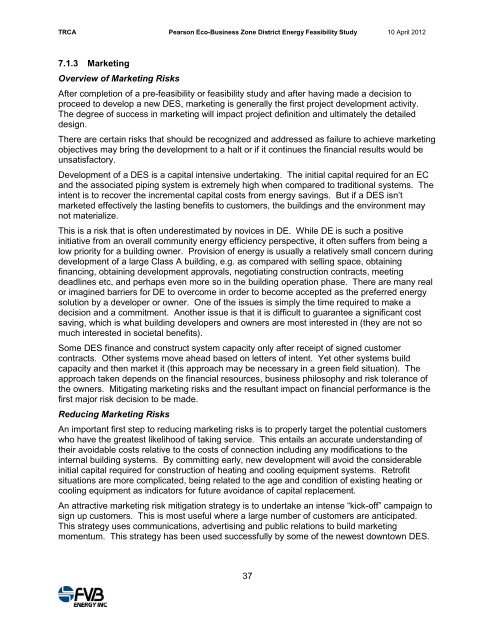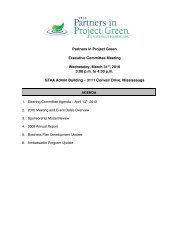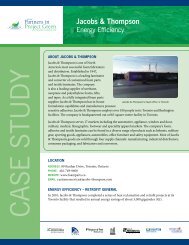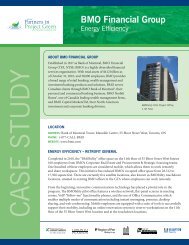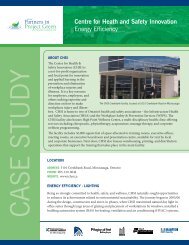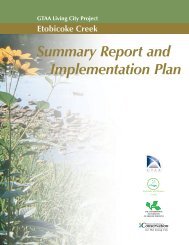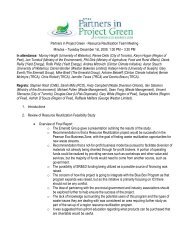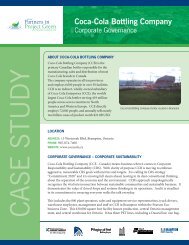Project Green District Energy Feasibility Study - Partners in Project ...
Project Green District Energy Feasibility Study - Partners in Project ...
Project Green District Energy Feasibility Study - Partners in Project ...
Create successful ePaper yourself
Turn your PDF publications into a flip-book with our unique Google optimized e-Paper software.
TRCA Pearson Eco-Bus<strong>in</strong>ess Zone <strong>District</strong> <strong>Energy</strong> <strong>Feasibility</strong> <strong>Study</strong> 10 April 2012<br />
7.1.3 Market<strong>in</strong>g<br />
Overview of Market<strong>in</strong>g Risks<br />
After completion of a pre-feasibility or feasibility study and after hav<strong>in</strong>g made a decision to<br />
proceed to develop a new DES, market<strong>in</strong>g is generally the first project development activity.<br />
The degree of success <strong>in</strong> market<strong>in</strong>g will impact project def<strong>in</strong>ition and ultimately the detailed<br />
design.<br />
There are certa<strong>in</strong> risks that should be recognized and addressed as failure to achieve market<strong>in</strong>g<br />
objectives may br<strong>in</strong>g the development to a halt or if it cont<strong>in</strong>ues the f<strong>in</strong>ancial results would be<br />
unsatisfactory.<br />
Development of a DES is a capital <strong>in</strong>tensive undertak<strong>in</strong>g. The <strong>in</strong>itial capital required for an EC<br />
and the associated pip<strong>in</strong>g system is extremely high when compared to traditional systems. The<br />
<strong>in</strong>tent is to recover the <strong>in</strong>cremental capital costs from energy sav<strong>in</strong>gs. But if a DES isn’t<br />
marketed effectively the last<strong>in</strong>g benefits to customers, the build<strong>in</strong>gs and the environment may<br />
not materialize.<br />
This is a risk that is often underestimated by novices <strong>in</strong> DE. While DE is such a positive<br />
<strong>in</strong>itiative from an overall community energy efficiency perspective, it often suffers from be<strong>in</strong>g a<br />
low priority for a build<strong>in</strong>g owner. Provision of energy is usually a relatively small concern dur<strong>in</strong>g<br />
development of a large Class A build<strong>in</strong>g, e.g. as compared with sell<strong>in</strong>g space, obta<strong>in</strong><strong>in</strong>g<br />
f<strong>in</strong>anc<strong>in</strong>g, obta<strong>in</strong><strong>in</strong>g development approvals, negotiat<strong>in</strong>g construction contracts, meet<strong>in</strong>g<br />
deadl<strong>in</strong>es etc, and perhaps even more so <strong>in</strong> the build<strong>in</strong>g operation phase. There are many real<br />
or imag<strong>in</strong>ed barriers for DE to overcome <strong>in</strong> order to become accepted as the preferred energy<br />
solution by a developer or owner. One of the issues is simply the time required to make a<br />
decision and a commitment. Another issue is that it is difficult to guarantee a significant cost<br />
sav<strong>in</strong>g, which is what build<strong>in</strong>g developers and owners are most <strong>in</strong>terested <strong>in</strong> (they are not so<br />
much <strong>in</strong>terested <strong>in</strong> societal benefits).<br />
Some DES f<strong>in</strong>ance and construct system capacity only after receipt of signed customer<br />
contracts. Other systems move ahead based on letters of <strong>in</strong>tent. Yet other systems build<br />
capacity and then market it (this approach may be necessary <strong>in</strong> a green field situation). The<br />
approach taken depends on the f<strong>in</strong>ancial resources, bus<strong>in</strong>ess philosophy and risk tolerance of<br />
the owners. Mitigat<strong>in</strong>g market<strong>in</strong>g risks and the resultant impact on f<strong>in</strong>ancial performance is the<br />
first major risk decision to be made.<br />
Reduc<strong>in</strong>g Market<strong>in</strong>g Risks<br />
An important first step to reduc<strong>in</strong>g market<strong>in</strong>g risks is to properly target the potential customers<br />
who have the greatest likelihood of tak<strong>in</strong>g service. This entails an accurate understand<strong>in</strong>g of<br />
their avoidable costs relative to the costs of connection <strong>in</strong>clud<strong>in</strong>g any modifications to the<br />
<strong>in</strong>ternal build<strong>in</strong>g systems. By committ<strong>in</strong>g early, new development will avoid the considerable<br />
<strong>in</strong>itial capital required for construction of heat<strong>in</strong>g and cool<strong>in</strong>g equipment systems. Retrofit<br />
situations are more complicated, be<strong>in</strong>g related to the age and condition of exist<strong>in</strong>g heat<strong>in</strong>g or<br />
cool<strong>in</strong>g equipment as <strong>in</strong>dicators for future avoidance of capital replacement.<br />
An attractive market<strong>in</strong>g risk mitigation strategy is to undertake an <strong>in</strong>tense “kick-off” campaign to<br />
sign up customers. This is most useful where a large number of customers are anticipated.<br />
This strategy uses communications, advertis<strong>in</strong>g and public relations to build market<strong>in</strong>g<br />
momentum. This strategy has been used successfully by some of the newest downtown DES.<br />
37


